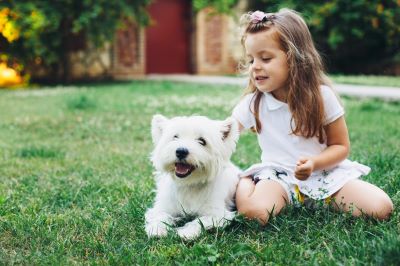Keeping children safe around dogs

Dogs can be unpredictable, as can kids. So as a dog owner, it's important to ensure the safety of your family, especially your children, when they’re around your furry friend. Most of the time our pets are happy and loyal companions, but they have their good and bad days too, just like the rest of us. That's why we've put together some tips to help you keep your children safe around dogs.
Helping children
Firstly, let’s remember that respect is a two-way street. It's important to teach your children to respect a dog's personal space. As much as dogs love attention and affection, they also need their own space to feel safe and secure. Teach your children to approach a dog calmly and slowly, and to always ask the owner's permission before petting them. If the owner says no, it's important to respect their decision and keep your distance.
Teaching children about body language
You should also teach your kids to recognise and understand a dog's body language. This can help them to identify when a dog’s feeling uncomfortable or threatened, and to give the dog space when needed. Some signs that a dog is feeling anxious or aggressive include growling, barking, showing their teeth and tensing their body. If your children notice any of these behaviours, it's important that they move away from the dog and tell an adult immediately.
When not to approach a dog
Children need to understand that dogs are not toys, and that there are certain times in a dog’s routine when children should keep their distance. For example, when a dog is sleeping, eating or chewing on a bone.
Being gentle
Without meaning to, kids can be a bit rough when picking up puppies and dogs. You should always supervise at these times, to make sure the child doesn’t get a nip or a scratch, or that the dog isn’t accidentally dropped.
Some children may also find it entertaining to tease a dog or startle them, which can lead to a dog becoming angry. Kids should be encouraged to be gentle and respectful when playing with dogs and shouldn’t touch a dog unless it can see them, to avoid any surprises.
Training your dog
The other side of the equation is ensuring that your dog is well-trained and socialised. Training your dog to follow basic commands like ‘sit’, ‘stay’, ‘come’ or not to jump up can help you to control their behaviour and prevent any accidents from happening. Socialising your dog from a young age can also help them to feel comfortable around children and other people, which means there’s less chance of any drama happening in the home.
Taking precautions
In addition to training and socialising your dog, there are some simple precautions you can take to keep your children safe. Always keep an eye on your children when they’re playing with or near your dog, and never leave them unsupervised. Keep your dog on a lead when you’re out in public, and make sure that your garden is securely fenced to prevent your dog from escaping.
At the end of the day, keeping your children safe around dogs is all about being aware and taking precautions. Kids love to play, and so do dogs, so they should get along famously, as long as both understand and respect each other's boundaries.
